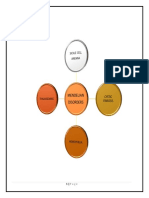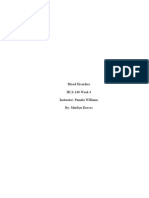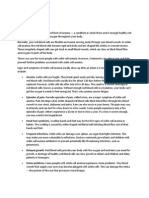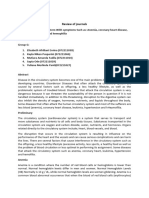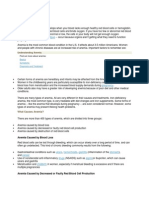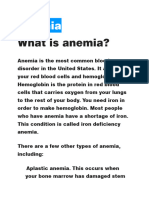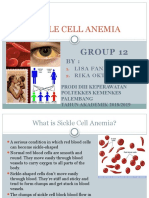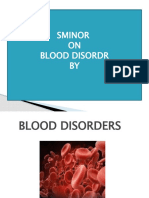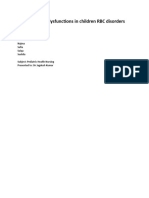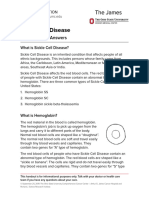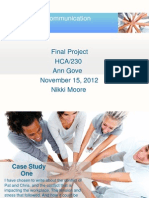Blood Disorders Paper
Blood Disorders Paper
Uploaded by
Anne McfarlandCopyright:
Available Formats
Blood Disorders Paper
Blood Disorders Paper
Uploaded by
Anne McfarlandCopyright
Available Formats
Share this document
Did you find this document useful?
Is this content inappropriate?
Copyright:
Available Formats
Blood Disorders Paper
Blood Disorders Paper
Uploaded by
Anne McfarlandCopyright:
Available Formats
Running head: BLOOD DISORDERS
Blood Disorders Ann Gove HCA/240 August 12, 2012 Margaret Mcgannon
BLOOD DISORDERS
Blood Disorders- Thrombocytopenia Spencer who has thrombocytopenia, a term given for low platelet count which is a blood disorder that involves the thrombocytes that play an important role in the clotting of blood. This condition is given when the term when for any reason your platelet count drops below the normal range. Normally a person has 150,000 to 450,000 platelets per microliter of circulating blood, it may surprise some to learn that your platelets only have a lifespan of about ten days, so your body is continuously producing new platelets in your bone marrow. Thrombocytopenia.(2012). There are many causes of thrombocytopenia and most often occurs as a result of a separate disorder such as Leukemia or an immune system problem or may be a side effect from a medication. Pregnancy can also cause mild thrombocytopenia, bacteria in the blood and sometimes thrombocytopenia may be idiopathic; meaning unknown and your body mistakenly identifies platelets as a threat and forms antibodies that attack them. The signs and symptoms of thrombocytopenia can appear suddenly or over time, mild thrombocytopenia often has no signs and is diagnosed through a blood test. The first signs of this disorder are external bleeding; this may cause purpura or petechiae. Purpura is purple, brown, and red bruises. This bruising may happen often and easily. Petechiae are small red or purple dots on your skin. (What Is Thrombocytopenia, n.d.). Other signs are prolonged bleeding even after a minor cut, nosebleeds or bleeding from gums when brushing your teeth. Other severe and possibly fatal signs of this disorder are internal bleeding such as blood in the urine or stool or bleeding from the rectum. Headaches and other neurological symptoms are signs of bleeding in the brain; although very rare they can and do occur. With Spencer experiencing symptoms of purpura over the past few weeks and experiencing this morning the petechiae around his eyes after coughing it is extremely important for him to see his doctor as these are signs of a severe
BLOOD DISORDERS
thrombocytopenia and further tests need to be evaluated to rule out a more serious reason for his thrombocytopenia. When preventing thrombocytopenia it depends on its specific cause. Usually this condition isnt one that can be prevented and is usually from an underlying cause, in the case of pregnancy induced thrombocytopenia it usually resolves itself after giving birth there are things that can be done to prevent health problems associated with this condition. One important lifestyle change is to avoid alcohol as alcohol slows the production of platelets. Avoid medicines that have decreased your platelet count in the past and that may affect your platelets such as aspirin and ibuprofen. It is important to avoid toxic chemicals as pesticides, and benzene slow platelet production. Talk to your doctor about getting vaccines for viruses that affect your platelets. Taking safety precautions is important in preventing injuries or bruising that can cause bleeding so its best to avoid contact sports. As shown below Thrombocytopenia
purpura (bruises) and petechiae (dots) in the skin. Thrombocytopenia pictures (2008).
BLOOD DISORDERS
Blood Disorders- Iron Deficiency Anemia When we talk of anemia and the many different types the most common form is iron deficiency anemia. In our bodies the red blood cells the most abundant cells in the human body, these cells are biconcave sacs filled with an iron rich oxygen carrying protein called hemoglobin. In iron deficiency anemia when the iron stores of the body becomes depleted, iron deficiency occurs and with this progression of this deficiency the red blood cells lose their shape and now appear cigar shaped, and they cannot provide your body with the iron or oxygen from them you need. (Zelman, Tompary, & Raymond, Mulvihill, "Chapter 7, A Systemic Approach," 2010). You get iron from certain foods, and your body reuses iron from old red blood cells some causes of this disorder is an iron poor diet (the most common), your body cannot absorb iron very well, even though youre eating enough iron. Long term blood loss usually through menstrual periods, or bleeding in the digestive tract is another cause of anemia to. Rapid growth in the first year of life or in adolescence, when more is needed can also cause this type of anemia. Another important cause of iron deficiency anemia in children is lead poisoning. Children like Lily a four- year- old girl who like many children her age is a picky eater. With a small budget for feeding her large family her mother cannot provide some of the important foods necessary to help prevent this common disorder and Lilys diet is mainly comprised of foods such as pasta, breads, and hot dogs, along with artificial fruit punch drinks. Symptoms of this type of anemia can vary from having no symptoms if this is a mild case to life threatening symptoms in severe cases symptoms can range from. The "University of Maryland Medical Center" (2011) website. Blue-tinged or very pale whites of the eyes Blood in the stools
BLOOD DISORDERS
Brittle nails Decreased appetite (especially in children) Fatigue Headache
Pale skin (pallor) Shortness of breath Irritability Unusual food cravings (called pica) Weakness
In Lilys case because her mother cannot provide the proper nutrition for her to receive enough iron from her diet, and Lilys pickiness of foods she has developed symptoms of iron deficiency anemia as is feeling tired all of the time, and is very pale both common symptoms of this disorder from an iron poor diet. Fortunately for Lily her disorder is one which is preventable and treatable but that doesnt mean its attainable. Unfortunately Lilys mom is in a predicament like many families are today, unable to afford the proper foods for their children to eat a healthy diet. The problem with something that seems so simple to fix can cause these children with this type of anemia to have a huge impact on their school performance, decreased attention spans, reduce their alertness, and have learning difficulties. According to University of Maryland Medical Center (2010). If the diet cannot include iron rich foods such as raisins, meats, (especially liver), fish, poultry, egg yolks, whole-grain breads, an iron supplement should be taken daily. Iron supplements have been shown to improve learning, memory, and cognitive performance.
BLOOD DISORDERS
Normal red blood cells notice the biconcave shape of the cells to carry the oxygen to the body and its The Weblog (2012) website
The Weblog (2012) website. Notice the shape of the iron deficiency anemia red blood cells, they are no longer biconcave but now are cigar shaped
BLOOD DISORDERS
Blood Disorders- Sickle Cell Anemia Before we discuss the blood disorder Sickle Cell disease or anemia that Davon may have lets first understand the disorder. Sickle cell affects the red blood cells (erythrocytes) their the oxygen carrying cells that carry oxygen from the lungs to the bodys tissue and taking the carbon dioxide back to your lungs to be exhaled. American Red Cross- Blood Components.(2011). While evaluating a child for Sickle Cell disease is usually done at birth before a baby comes home from the hospital by doing a simple blood test called a hemoglobin electrophoresis. With Davons mother a known carrier he should have been previously tested, but with a new Pediatrician and Davon soon starting school it is good choice for his mom to have him tested at this time, and with Davon showing no symptoms of the disease at this time it is helpful to know if he has it or if he is a carrier like his mom. The sickle cell disease or sickle cell anemia as commonly known is an incurable inherited blood disease, with an average life span of 50-60 years of age, but it depends on the type of disorder and how it affects their health. This disease is caused by abnormal hemoglobin type called hemoglobin S, protein part of the RBCs that carries the oxygen and is an inherited blood disease that is passed genetically from each parent with the gene. Sickle cell disease is common in people whose ancestors are from Africa, India, Middle East, and Mediterranean countries are more likely to inherit the gene. If only one parent has the gene they can pass it on to the child, and they will have the sickle-cell trait, which means you dont have the disease but can pass the gene onto your children. Approximately 10% of African-Americans have the sickle cell trait. Sickle cell disease is when the normally round red blood cells are in the shape of a sickle or crescent moon, in normal red blood cells the life span is 120 days, compared to someone with sickle cell the life span is usually no more than 20 days. WebMD(2010). Normally red blood
BLOOD DISORDERS
cells move easily through the blood vessels, taking oxygen to your body, but in sickle cells they develop crystals in the cells making them rigid and inflexible and can cause them to get stuck and block the blood vessels resulting in hemolytic anemia and cause pain, and without oxygen getting to the organs they can be damaged as well as harming muscles and bones. This condition is an extremely painful condition resulting in decreased quality of life and lifelong issues with infections, pain, anemia and strokes. (Zelman, Tompary, & Raymond. J. Holdaway. Mulvihill. M.L., A Systemic Approach, 2010). The symptoms of sickle cell usually do not occur until the child is around six months of age, this is because until six months the infant is protected by the high fetal hemoglobin (hbf) in their blood which protects their red blood cells from sickling. WebMD (2010). Sickle cell anemia is called a crisis in which painful episodes occur that can last anywhere from hours to days. During these crisis there can be pain in the bones of the back, the long bones, and in the chest. Some may experience an episode every few years and others may have many episodes each year, requirering hospitalization for symptoms of fatigue, abdominal pain, jaundice (yellowing of the skin, eyes), shortness of breath, rapid heart rate (tachycardia), infections, fever and pain management and intravenous fluids. Some people may not know they have the disease until a crisis occurs, or realize they are carriers so it is important for anyone who is unsure of their sickle cell status to be tested. A.D.A.M. (2010). While sickle cell is an inherited, incurable disease, and it is possible for people to die from the disease it is a manageable disease. Early treatment for children includes daily antibiotics from two months to five years of age to help prevent infections and routine immunizations are important. Many with this disease receive transfusions of healthy red blood cells to help carry oxygen to their tissues more effectively and treat complications. Some ways a
BLOOD DISORDERS
person with this disease try to stay as healthy as possible and maybe lessen the crisis episodes or the severity are to learn the triggers of a crisis. Avoid triggers like cold, windy temperatures, dehydration, and avoid too much exercise. Low oxygen caused by smoking, plane flights, and high altitudes is another common trigger. This may help in decreasing the flare-ups but this disease cannot be prevented. WebMD.(2010). The most important thing to do is to eat a balanced, healthy diet, take medications, including folic acids, exercise in moderation, get plenty of rest, and avoid alcohol, drugs. Remember to learn as much as you can about your disease so you can live a full active life, knowing your limits and triggers. Miller.MD.(2009).
BLOOD DISORDERS
10
Sickled Cells
Normal Cells
The Mason (2009) website.
The Mason (2009) website.
The "National Heart Lung And Blood Institute" (2011) website. Depiction of normal RBCs in the veins and the sickle cells in the veins and causing a crisis by clumping up in the veins causing pain and other complications.
BLOOD DISORDERS
11
REFERENCES
Zelman, M., Tompary, E., & Raymond, Mulvihill, M.L. (2010). Human diseases (7th ed.). Retrieved from The University of Phoenix eBook Collection. Thrombocytopenia pictures. (2008). American Society for Clinical Pathology, (570981), Retrieved from http://www.medscape.com/viewarticle Thrombocytopenia. (2012, April). Mayo Clinic, DS00691(), Retrieved from http://www.mayoclinic.com What Is Thrombocytopenia. (n.d.). National Heart Lung and Blood Institute, (), Retrieved from http://http;//www.nhlbi.nih.gov Dugdale, D.C. (2010, February 5). Thrombocytopenia. (2012). Retrieved from http://www.urac.org Health Central. (2012). Retrieved from http://www.healthcentral.com Children-Iron Deficiency Anemia. (2010). University of Maryland Medical Center. Retrieved from http://www.umm.edu Glader, B. (2007). Nelson Textbook of Pediatrics (18th ed.). Philadelphia, PA: SaundersElsevier University of Maryland Medical Center. (2011). Retrieved from http://www.umm.edu/ency/article/007134sym.htm Weblog. (2012). The NP Mom. Retrieved from http://thenpmom.wordpress.com/2012/02/15 Zelman, M., Tompary, E., & Raymond. J. Holdaway. Mulvihill. M.L., (2010). Human Diseases. Retrieved from The University of Phoenix eBook Collection. American Red Cross- Blood Components. (2011). Retrieved from http://www.redcrossblood.org Miller.MD. R. E. (2009, July). Sickle Cell Anemia. Teens Health.org, (), p 1-4. http://www.kidshealth.org
BLOOD DISORDERS
12
WebMD. (2010). Retrieved from http://www.webmd.com Chen. MD, Y. (2011). Sickle Cell Anemia- PubMed Health. Retrieved from http://www.ncbi.nlm.gov Mason, James. R. (2009). Health all refer. Retrieved from http://health.allrefer.com/pictures-images National Heart Lung and Blood Institute. (2011). Retrieved from http://www.nhlbi.nih.gov/health
You might also like
- Biology Investigatory Project On Mendelian DisordersDocument42 pagesBiology Investigatory Project On Mendelian DisordersLalit Kumar94% (16)
- Biology Investigatory Project On Mendelian DisordersDocument42 pagesBiology Investigatory Project On Mendelian DisordersPrasaanth Rock86% (14)
- المستند (46) كتاب الجلوةDocument11 pagesالمستند (46) كتاب الجلوةManal HassanNo ratings yet
- HCA 240 WK 4 Blood DisordersDocument6 pagesHCA 240 WK 4 Blood Disordersmarilyn1221_55503248No ratings yet
- Untitled DocumentDocument16 pagesUntitled DocumentDinesh DoraNo ratings yet
- Nursing Diagnosis and Nursing Interventions For HirschsprungDocument5 pagesNursing Diagnosis and Nursing Interventions For HirschsprungAhmed Altrafe100% (2)
- Sickle CellDocument7 pagesSickle Cellmahmoudmustapha93No ratings yet
- Sickle Cell AnemiaDocument7 pagesSickle Cell AnemiakazelleNo ratings yet
- Sickle Cell AnemiaDocument3 pagesSickle Cell Anemiakarenkaren09No ratings yet
- Anemia in ChildrenDocument4 pagesAnemia in ChildrenTeslim Raji100% (2)
- Running Head: BLOOD DISORDERS 1Document6 pagesRunning Head: BLOOD DISORDERS 1serenity779No ratings yet
- Sickle Cell Anemi1Document13 pagesSickle Cell Anemi109204445328No ratings yet
- Anemia Causes, Symptoms, Diagnosis, TreatmentsDocument1 pageAnemia Causes, Symptoms, Diagnosis, TreatmentsBellaNo ratings yet
- What Is Anemia?Document7 pagesWhat Is Anemia?Monica Roly VonitaNo ratings yet
- Sickle Cell AnemiaDocument15 pagesSickle Cell AnemiakavitharavNo ratings yet
- Anemia PresentDocument6 pagesAnemia PresentPhilia HandiasNo ratings yet
- Review Jurnal Anfisman Grup G English VersionDocument11 pagesReview Jurnal Anfisman Grup G English VersionKayla NikenNo ratings yet
- MODERATOR: A Very Good Morning I Bid To Everyone. Today Today We Will Be DoingDocument4 pagesMODERATOR: A Very Good Morning I Bid To Everyone. Today Today We Will Be DoingFadliana LianaNo ratings yet
- Sickle Cell AnemiaDocument18 pagesSickle Cell AnemiaArnim KumarNo ratings yet
- Sickle Cell AnemiaDocument10 pagesSickle Cell AnemiaNader Smadi100% (2)
- Sickle Cell AnemiaDocument20 pagesSickle Cell AnemiaAnastasiafynn100% (1)
- Sickle Cell AnemiaDocument2 pagesSickle Cell AnemiaJosephine NievesNo ratings yet
- hlth1020 SCDDocument7 pageshlth1020 SCDapi-302025926No ratings yet
- Biology Investigatory Project On Mendelian DisordersDocument10 pagesBiology Investigatory Project On Mendelian DisordersWS ARYAN YTNo ratings yet
- Sickle Cell DiseaseDocument10 pagesSickle Cell DiseaseAlaa Elsaid Attia Ahmed Ahmed AlassalyNo ratings yet
- Sickle Cell Anemia, A Simple Guide To The Condition, Treatment And Related ConditionsFrom EverandSickle Cell Anemia, A Simple Guide To The Condition, Treatment And Related ConditionsNo ratings yet
- What Is AnemiaDocument3 pagesWhat Is AnemiaPalakang PetotNo ratings yet
- AnemiaDocument20 pagesAnemiaJane ColeNo ratings yet
- Anemia Bulan SabitDocument19 pagesAnemia Bulan SabitRyujin daughterNo ratings yet
- Sickle Cell AnaemiaDocument8 pagesSickle Cell AnaemiaBhargav DesaiNo ratings yet
- Sickle Cell DiseaseDocument7 pagesSickle Cell Diseasekarenkaren09100% (2)
- Sickle Cell Anemia Is One of A Group of Disorders Known As Sickle Cell DiseaseDocument6 pagesSickle Cell Anemia Is One of A Group of Disorders Known As Sickle Cell DiseaseAbduladheemNo ratings yet
- Sickle Cell DiseaseDocument8 pagesSickle Cell DiseaseShafieyah ShafiefieNo ratings yet
- Understanding Anemia - The BasicsDocument4 pagesUnderstanding Anemia - The BasicsKalyan BarmanNo ratings yet
- Genetic Disorders: John Benedict B. Merlin 11 - PolarisDocument7 pagesGenetic Disorders: John Benedict B. Merlin 11 - PolarisJohn MerlinNo ratings yet
- Daug - Blood DiseasesDocument3 pagesDaug - Blood DiseasesFRANCINE JULIA DAUGNo ratings yet
- Brief - Sickle Cell AnemiaDocument6 pagesBrief - Sickle Cell AnemiaJologs AggasidNo ratings yet
- Sickle Cell AnaemiaDocument18 pagesSickle Cell AnaemiajhvjNo ratings yet
- Sickle CellDocument10 pagesSickle CellJulla CutaranNo ratings yet
- Child With Blood Disorders PPT PRDocument114 pagesChild With Blood Disorders PPT PRchaarviNo ratings yet
- Sickle Cell AnemiaDocument12 pagesSickle Cell Anemiakozume962No ratings yet
- Sickle Cell AnemiaDocument7 pagesSickle Cell Anemiaafsas rpNo ratings yet
- Sickle Cell Anaemia by SALDocument4 pagesSickle Cell Anaemia by SALSahar Ahmed LaskarNo ratings yet
- Anemia PPT - KeyDocument16 pagesAnemia PPT - KeyAyman RehmanNo ratings yet
- AnemiaDocument13 pagesAnemiaharizmnNo ratings yet
- Anmol's Investigatory Project 1Document7 pagesAnmol's Investigatory Project 1Anmol KatariaNo ratings yet
- Group G HEMATOLOGICAL DISORDER GGDocument26 pagesGroup G HEMATOLOGICAL DISORDER GGhkvirk47No ratings yet
- Sickle Cell 2Document6 pagesSickle Cell 2abdurrahmanm569No ratings yet
- Research Paper AnemiaDocument4 pagesResearch Paper Anemiaeh041zef100% (1)
- Anemia: Arranged By: Mishael Immanuel Dae Pany (2014.03.010) Firman Syalasah (2014.03.006)Document13 pagesAnemia: Arranged By: Mishael Immanuel Dae Pany (2014.03.010) Firman Syalasah (2014.03.006)kharisma restuNo ratings yet
- Fatigue: What Is Anemia?Document3 pagesFatigue: What Is Anemia?Annapurna DangetiNo ratings yet
- Biology: Investigatory Project OnDocument24 pagesBiology: Investigatory Project OnManish KarnaniNo ratings yet
- NCPCR Thalassemia and SCDDocument20 pagesNCPCR Thalassemia and SCDBENE FACTORNo ratings yet
- Princess Durru Shehvar College of Nursing B.SC Nursing 2 Year Online Coaching Community Health Nursing - I AnemiaDocument6 pagesPrincess Durru Shehvar College of Nursing B.SC Nursing 2 Year Online Coaching Community Health Nursing - I AnemiaAnonymous hYMWbA100% (1)
- Low HemoglobinDocument2 pagesLow HemoglobinChefiza SuhaimayNo ratings yet
- Study of Sickle Cell Anemia NewDocument12 pagesStudy of Sickle Cell Anemia NewS.NagarajanNo ratings yet
- BiologyDocument16 pagesBiologyVedant X ANo ratings yet
- Types Of Hemolytic Anemia, A Simple Guide To The Condition, Treatment And Related ConditionsFrom EverandTypes Of Hemolytic Anemia, A Simple Guide To The Condition, Treatment And Related ConditionsNo ratings yet
- Types of Anemia, A Simple Guide To The Condition, Diagnosis, Treatment And Related ConditionsFrom EverandTypes of Anemia, A Simple Guide To The Condition, Diagnosis, Treatment And Related ConditionsRating: 5 out of 5 stars5/5 (2)
- A Simple Guide to Anemia, Treatment and Related DiseasesFrom EverandA Simple Guide to Anemia, Treatment and Related DiseasesRating: 4.5 out of 5 stars4.5/5 (2)
- Training and Development - Docx HCS/341Document7 pagesTraining and Development - Docx HCS/341Anne McfarlandNo ratings yet
- Environmental Effects On Our Human HealthDocument2 pagesEnvironmental Effects On Our Human HealthAnne McfarlandNo ratings yet
- Interpersonal Communication PPP For FinalDocument17 pagesInterpersonal Communication PPP For FinalAnne McfarlandNo ratings yet
- Chlamydia Power PointDocument19 pagesChlamydia Power PointAnne McfarlandNo ratings yet
- Environmental Effects On Our Human HealthDocument2 pagesEnvironmental Effects On Our Human HealthAnne McfarlandNo ratings yet
